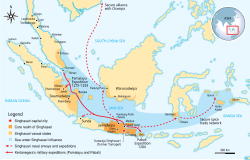Singhasari
| Singhasari | ||||||||||
|
||||||||||
|
Expansion of Singhasari during the reign of Kertanegara
|
||||||||||
| Capital | Tumapel, later called Kutaraja Singhasari (modern outskirt Malang) | |||||||||
| Languages | Old Javanese, Sanskrit | |||||||||
| Religion | Kejawen, Hinduism, Buddhism, Animism | |||||||||
| Government | Monarchy | |||||||||
| Raja | ||||||||||
| • | 1182–1227 | Ken Arok | ||||||||
| • | 1268–1292 | Kertanegara | ||||||||
| History | ||||||||||
| • | Coronation of Ken Arok | 1222 | ||||||||
| • | invasion by Jayakatwang of Kediri | 1292 | ||||||||
| Currency | Native gold and silver coins | |||||||||
|
||||||||||
Singhasari was a Javanese Hindu–Buddhist kingdom located in east Java between 1222 and 1292 (today Indonesia). The kingdom succeeded the Kingdom of Kediri as the dominant kingdom in eastern Java. The kingdom's name cognate to Singosari district of Malang Regency, located several kilometres north of Malang city.
Singhasari (alternate spelling: Singosari) was mentioned in several Javanese manuscripts, including Pararaton. According to tradition, the name was given by Ken Arok during the foundation of the new kingdom to replace its old name, Tumapel, located in a fertile highland valley which today corresponds to the area in and around Malang city. It derived from sanskrit word singha which means "lion" and sari or saree which in Old Javanese could means either "essence" or "to sleep". Thus Singhasari could means "the essence of lion" or "sleeping lion". Although lion is not an endemic animal of Java, the depiction of lion as symbolism can be found in Javanese culture, especially attributed to the influence of Hindu-Buddhist symbolism.
Singhasari was founded by Ken Arok (1182-1227/1247), whose story is a popular folktale in Central and East Java. Most of Ken Arok's life story and also the early history of Singhasari was taken from the Pararaton account, which also incorporates some mythical aspects. Ken Arok was an orphan born of a mother named Ken Endok and an unknown father (some tales stated he was a son of god Brahma) in Kediri kingdom’s territory.
...
Wikipedia

